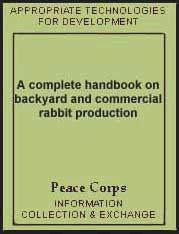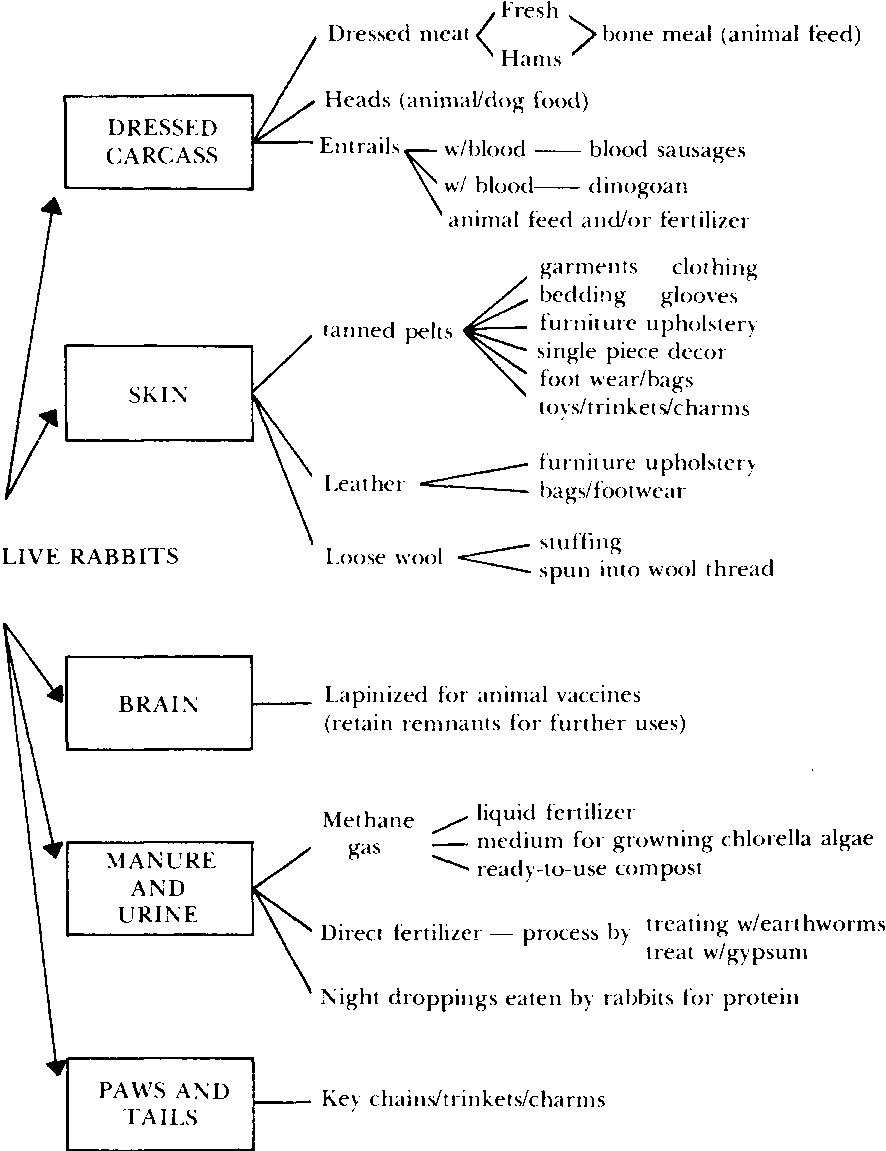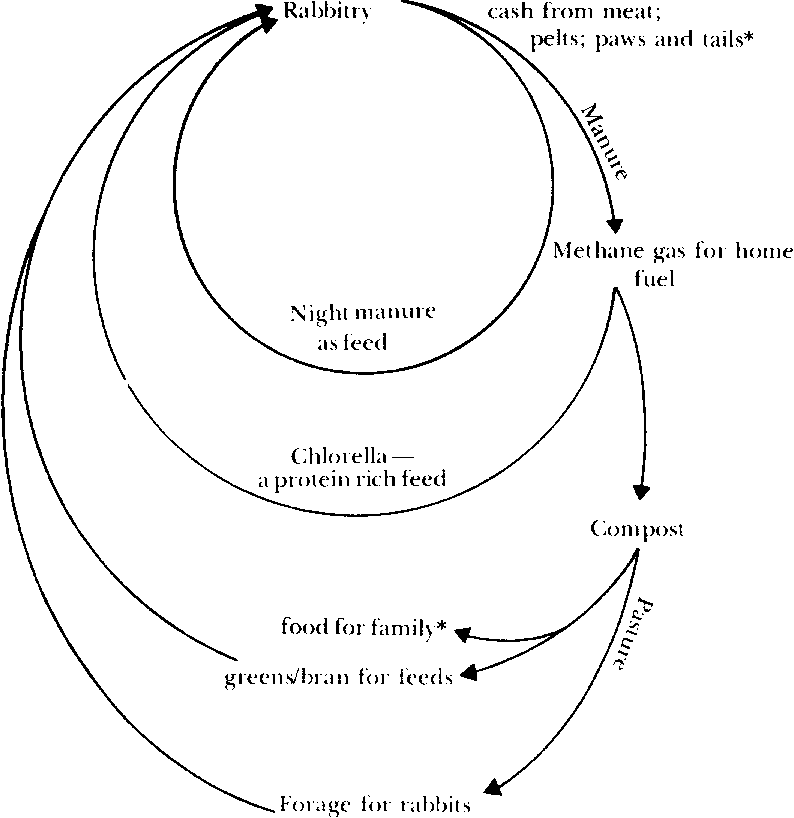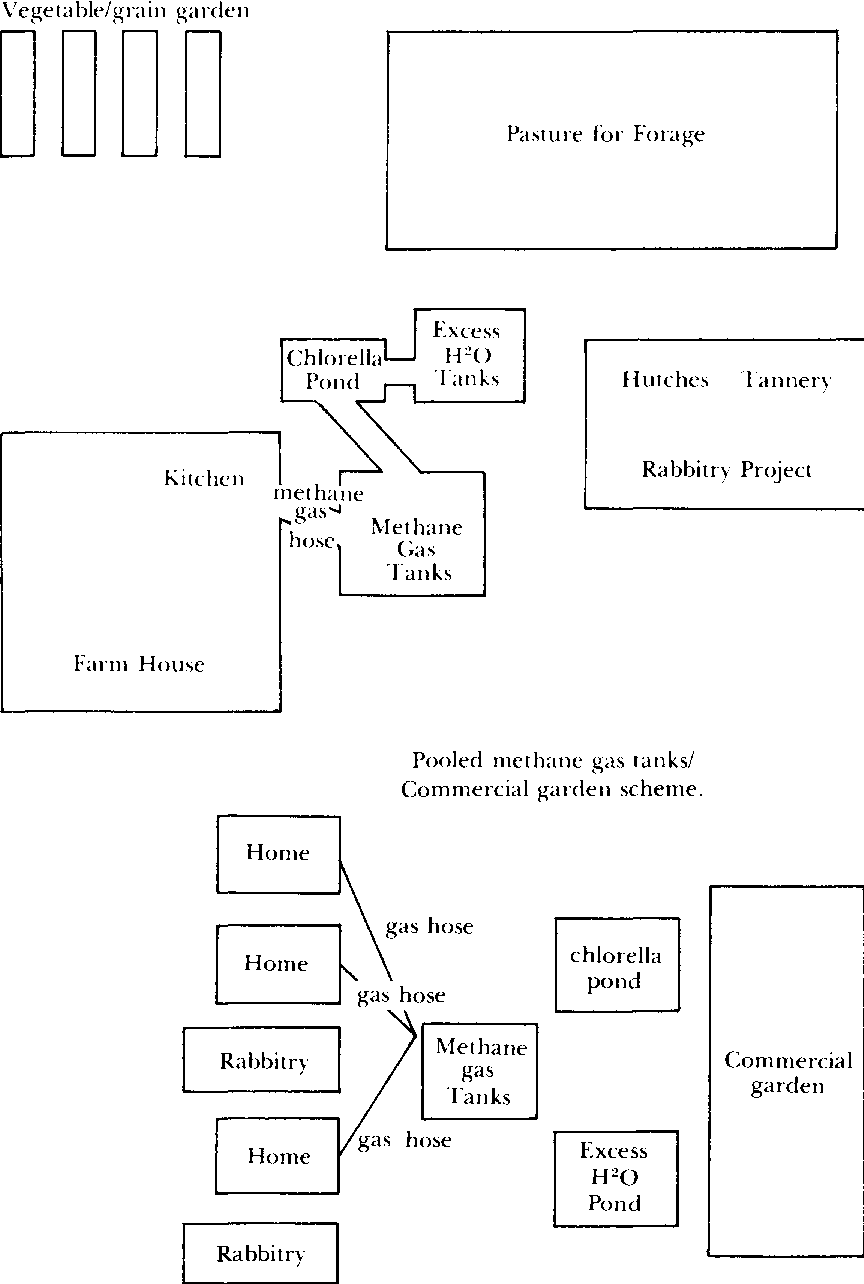
Multiple-project approach to rabbitry[edit | edit source]
Dorothy M. Hamada
Provincial Rural Youth Officer
Benguet Province
Reducing production costs and the waste products that tend to accumulate are two of the most serious and wasteful problems that confront any agriculture enterprise. Moreover, agricultural ventures require that its workers be within constant reach of the project while in most instances underemploying these same workers.
This paper seeks to show how it is feasible for a rabbitry to be maintained at much reduced costs up to a point of self-liquidating status; convert potential waste products into economic by-products; fully employ farm labor; and generate cottage industries which not only promise cash for effort expended but also serve as an outlet for native ingenuity and creative talent.
Rabbits are protein-rich yet cheap sources of human food, a fact documented by Germany's major reliance on this animal as a source or their protein during World War I and II. It is a livestock project which can thrive on grasses and waste and/or excess farm greens which is an asset of vital importance in times of economic depression and food/feed shortage such as we face today. To top it all, schemes presented here will show that the products and by-products from a total rabbitry supply the basic needs of any ordinary family fulltime for food, fuel, cash and clothing.
This is one project meant for the average Filipino family, farmer or suburbanite. It is one way of providing work on the farm, thus, reducing urban-ward migration.
THE SCHEME:
Any rabbitry project, whether small or large, must be fully utilized if it is to be truly economic and beneficial to the average Filipino family. It should not produce a lot of waste or garbage which tends to isolate the farm from neighbors clue to foul ordor and/or fly, mosquito, or rat infestation. In other words, we much extract all we can from one single rabbit project.
On the whole, a rabbit project provides a very versatile meat for the table, pelts and/or leather for clothing, upholstery, bag/gloves and decor material. In addition, rabbits can be lapinized for animal vaccines. It supplies manure which can be further utilized to generate odorless gas. The methane gas tank produces ready-to-use compost; excess tank liquid in which to grow chlorella algae; and water for the garden. Night dung is eaten by the rabbits. Nothing is wasted, unfavorable odor is reduced and under-employment of farm labor is prevented.
While the scheme illustrated in Figure 69 is for a unit farmstead, assuming that the rabbitry project is large enough to supply a methane-gas tank with sufficient manure, the same scheme may be stretched with several small rabbitries pooling their waste into single methane gas tank and alternately using the fuel generated as well as the by-produces of chlorella algae and excess liquid and compost for their backyards or communal gardens.
A second alternative is to hook-up the methane-gas tank to the watersealed toilet to supply a single methane gas tank for the farm household.
A. Meat
Dressed rabbits can be prepared in several ways, the most favorite being the same as those prepared out of chicken or goat meat. When rabbits are fed predominantly on grasses or greens, it is recommended that the rabbits be fed concentrate diets for a week prior to slaughter to remove the grassy smell and produce tastier meat.
When slaughtering more than one rabbit for home consumption, cure the remaining meat with your favorite ham recipe. Cured meat commands higher prices than fresh meat.
The heads which are not sold with the dressed rabbit can be sold to dog keepers for dog food on a piece or kilo basis.
Entrails are either cooked into dinogoan, blood sausages or steamed and dried for animal feeds.
B. Skins
Rabbits are processed into pelts which are trimmed after tanning and sold as single pieces, cut into novelty articles, bags, shoes and accessories or sewn together for coats, stoles, blankets or upholstery.
Pelts can be dehaired and processed into soft leather for bags, or shoes. The shedded wool is cleaned and dried for stuffing pillows or matresses or spun into wool thread.
Trimmings are further made into trinkets like flowers, car decor, bar pins and the like.
C. Brain
The Bureau of Animal Industry buys rabbits regularly for experiment animals or lapinizes them for animal vaccines. A community or large rabbitry concern can coordinate with the BAI for this purpose, thus reducing the cost of vaccines and utilizing such parts of the animal that are not used in the preparation of vaccines.
D. Manure
Here are several alternatives to the use of rabbit manure. Consideration has also been made of people's reluctance to handle manure and their rejection of rabbit raising due to its unfavorable odor.
Alternative I - use single hutches and allow the rabbit dung to fall directly into 15 mm deep pits under the hutch. Plant earthworms in the accumulated manure to pulverize the manure and substantially reduce odor.
Alternative II - Prepare the same pits under the hutch and sprinkle them with gypsum once-a-week. Gypsum will neutralize the odor and lock-up the nitrogen in the manure which would otherwise be lost in the air. This will produce richer fertilizers.
Alternative III - Construct methane gas tanks into which the manure and urine are placed. Seven to ten wheel-barrels full of manure will fill a one by one meter tank capable of generating enough fuel for two-hour daily use for two-month periods. The length of service of a tank-full depends on the weather. Warmer climates cause faster fermentation.
Construct one to several shallow ponds adjacent to the methane gas tank in which chlorella, a green algae can grow on excess tank liquid. The chlorella if sieved and air-dried, provides 60 per cent proteinrich feed for the rabbits. With this, you can reduce your cost of concentrates by more than 50 per cent (See Burau of Fisheries for information on related backyard fish ponds).
A second smaller but creeper pond into which further excess water can flow, will conserve nutrient-rich water for watering and fertilizing pastures and grain/vegetable gardens. The rationale for narrower but deeper ponds is to reduce evaporation. The accumulated water is also helpful during the dry summer months when water is scarce.
The decomposed solid matter inside the methane gas tank, when removed, is ready-to-use compost for the garden. Since it has already been decomposed, the fertilizer will not harm the plants or cause nitrogen-starvation which is usually a problem when utilizing fresh manure.
If grain/vegetable gardens are maintained, the products can be used in the kitchen while the excess greens and bran from the grain provide carbohydrates, mineral and vitamins for the rabbits. All marginal lands within and around the farm should he planted to pasture grasses and legumes for year-round supply of roughage for the rabbits. With this system you assure the rabbits adequate feed while having ready fertilizer for the pasture and gardens.
Rabbits are known to eat their own night droppings. These are protein rich feed supplements.
E. Paws and Tails
Paws and tails are treated in formaline and dried. Key chains and lucky charms and trinkets can be crafted from treated paws and tails.
The rabbitry, maintenance of the methane gas tank and the vegetable grain gardens can be the concern of the farmer and male members of the farm household while the home industry projects like tanning and leather craft can be done by the female members of the farm household.
Adjustment in Case of Small Rabbitries
Rabbit projects like backyard rabbitries whose main concern is to provide meat for the table have no reason to waste any of their by-products simply because their projects are too small to economically operate any of the by-product enterprises. It is recommended that tanning; sale of excess meat, pelts and crafted articles; even the operation of a methane gas tank and the gardens be a communal effort; that is, some sort of cooperative venture among neighbors.
This will greatly reduce capital investment and overhead expenses per entrepreneur.
Conclusion:
There is nothing in a rabbitry venture which cannot be converted into a useful by-product for home consumption or converted into cash. It requires only a little extra energy to engage in these side-enterprises. Working with rabbits is challenging, creative, and rewarding. So why not go into it? But WASTE NOTHING!
FIGURE 67 - MULTIPLE-USE OF RABBIT AND BY-PRODUCTS*
*Absolutely no waste. Provides jobs for everyone. Home-industry for maximum farm labor utilization.
FIGURE 68 - SELF-LIQUIDATING YOUR RABBITRY PROJECT THRU RECYCLING
*Meat; pelts; paws and tails; methane gas and garden products are used for home consumption or may be converted into cash for family use.
Night manure; chlorella; grain bran; surplus garden greens and forage from pastures are all recycled products from rabbitry making it self-liquidating.
FIGURE 69 - SUGGESTED PLACEMENT OF SUB-UNITS OF AN INTEGRATED RABBITRY PROJECT


